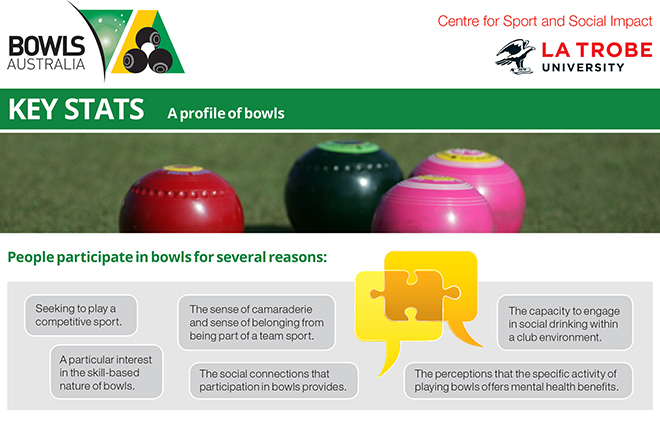Report identifies motivation for bowls participation
In 2012, Bowls Australia commissioned La Trobe University to undertake pivotal research into key areas of the sport of bowls In 2012, Bowls Australia commissioned La Trobe University to undertake pivotal research into key areas of the sport of bowls, specifically looking at what the physical and mental characteristics of a bowler is and what motivates participation.
Led by Professor Russell Hoye, the research project team included Associate Professors Kevin Brown and Matt Nicholson, Dr Emma Sherry and Tom Clement from La Trobe University’s Centre for Sport and Social Impact.
The research findings for Bowls in Australia, titled ‘Building an evidence base to increase participation in Lawn Bowls’, was the result of a two-stage process and many months of personal interviews and paper surveys.
In fact, the initial stage of the project consisted of 90 face-to-face semi structured interviews across 18 clubs in Australia with current bowls club members bowling in traditional pennant competitions, social bowlers, previous non-current members and club committees and staff.
The philosophy of the first stage was to gather data relating to seven major themes including;
• Reasons for playing
• Mental and physical health benefits
• The ‘bowls’ experience
• Bowls formats
• Changes in the bowls experience
• Why people stop bowling
• Club survival challenges
The next stage included 4000 club members from 100 clubs across the country completed a paper survey that focussed on motivations for playing, satisfaction levels from their playing experience and their commitment to remain involved in bowls among others.
Bowls Australia Chief Executive Neil Dalrymple was happy with the findings of the research project and the insights identified for the future growth of the sport. “It is extremely important to BA and our State and Territory Associations and especially all bowling clubs around Australia to know more about our participants and what motivates them to play and stay playing,”
Dalrymple said. “It is equally important for us to identify why people cease playing or never choose to take the game up in a competitive sense or become club members and remain irregular participants primarily through social bowls.”
“This research project and its findings allowed us to work through the psyche and desires of ‘a bowler’ and what is required for us to ensure participation in the sport continues to rise.”
“More diverse and appealing membership offerings, shorter formats of the game and more flexible playing times are key outcomes that will assist us to deliver the sport to a broader audience over the important next phase of the sports development.”
Click here to view the two-page snapshot of the La Trobe University research findings
Click here to view the full report



